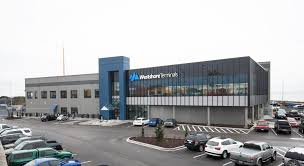
Canada’s abundant mineral resources have led to an economic surge over the past decade, with shale oil occupying most of the newspaper columns. However, its coal resources - coming to the fore again after recent legislation changes in the neighboring US - are also enormous. By some estimates, the Peace River and Kootenay coalfields alone are estimated to hold more than two billion tonnes of coal.
That’s more than enough to satisfy Canada’s domestic demand, creating an opportunity for the country’s exporters. The biggest of these is Westshore Terminals, located in Delta, BC on Canada’s western seaboard, in the greater Vancouver region. Westshore Terminals is Canada’s largest and most technologically advanced coal export terminal with an annual export capacity of 33 million tonnes. We decided to take a closer look.
Background
Founded in 1970, Westport Terminals is fast approaching a half century of providing an invaluable cog in North America’s mining value chain. In 2018, it is the biggest coal distributor in North America by tonnage, shipping both countries’ output to over 20 countries worldwide. This success contributed to the company achieving revenues of C$330 million in financial year 2017 - up just under 5% on the 2016 figures.
In 2017, its export destinations primarily consisted of South Korea, Japan and China, which made up around 80% of the company’s entire distribution. The remaining 20 countries were comprised of Latin American countries, Taiwan and even countries as far away as Europe. Regardless of what anybody says - there’s still huge global demand for coal - with as much as 40% of the planet depending on its almost entirely.
One look at the company’s vital statistics and it’s not difficult to see how it achieved this kind of growth in a relatively short period; the terminal size at Delta is 133 acres with on-site storage of over 2 million tonnes. Its peak berth loading is 7,000 tonnes per hour with a throughput capacity of 33 million tonnes. No other terminal in North America passes so much through its hands on a daily basis.
This throughput is in large part thanks to the utilization of a constant desire to improve the terminals’ offering. Its current state of the art range allows it to offer its clients reliable, fast and efficient delivery of their coal. It contains 2 rail loops, rotary dumpers and deep sea berths, 4 kilometres in the rail causeway, 4 stacker containers and 7 kilometers of high-speed conveyors. The company’s operations are handled by around 350 full-time employees.
It’s a non-stop process. In 2015, management at the firm announced that it would invest C$275 million in new infrastructure by 2020 to ensure that the company remained the leader of its industry. The project included replacing its Berth One shiploader and three stacker-reclaimers as well as building a new HQ, shops and employee facilities complex. The work is still ongoing and nearing completion.
Sustainability Work
Canada maintains a clean reputation in mining, mainly because its companies do everything in their power to use sustainable practices. Westshore Terminals is no different. It maintains an ongoing commitment to operate responsibly and protect the environment in and around its terminal. It recognizes that it needs to make as little impact as possible on that environment, whether it be the flora, fauna and or water.
Evidence of this commitment can be seen in the eco-friendly facilities that Westshore Terminals has installed on its facilities, which include high tower sprays, mobile air monitoring units, big gun ground-level water sprays. In addition, it has cultivated a reef system near its operations where animals like sea lions, bald eagles, seagulls and of course, fish and crabs, have managed to thrive over the past few years.
Away from the environment, Westshore Terminals is also an active participant in the community, contributing to well over 100 local community organizations. A recent notable example being the C$100,000 it to provided to Reach Child and Youth Development Society’s Building for Children Together capital project to build a new child development centre in Ladner for children and youth with developmental disabilities.
Partners and Suppliers
To maintain its position at the top of the industry ladder, Westshore Terminal has had to develop a number of mining industry contacts both on the supply and demand sides. However, that’s just to speak of its role as a distributor. In-between, it has the largest coal terminal in North America to manage and a number of important partners helping it to do so.
These companies are primarily giants of Canadian industry like railway firms CN Rail and BNSF Railway, QCA Systems Ltd, iSAM AG, All Voltage Electric & Controls and Brymark. But there’s also Swedish mining giant Sandvik, as well as smaller local firms like LNS Services and Rhino Shrink Wrap Inc. Finally, the company is also a valued member of industry associations such as the Coal Alliance, the Jim Pattison Group, Canadian Pacific and the Coal Association of Canada.
Westshore’s Future is Ironclad
A recent analyst report of Westshore Terminals’ investment outlook said that the stock was ‘ironclad’ thanks to the competitive advantages that it had built up during the year. It also noted that competitors looking to begin similar operations on Canada’s western seaboard - the Gateway Pacific and Millennial Terminals - would be delayed, allowing Westshore Terminals to consolidate its own position as industry leader.
The company’s third quarter financial statements for 2018 shows that it is on track to beat its best ever year, in terms of revenue and throughput. And that doesn’t even take account of the new infrastructure investments which haven’t yet finished. It seems ideally positioned, therefore, to continue to capitalize on Asia’s booming economies. For Westshore, the future is assured.
DOWNLOAD
 Westshore-AM-Oct18.pdf
Westshore-AM-Oct18.pdf














